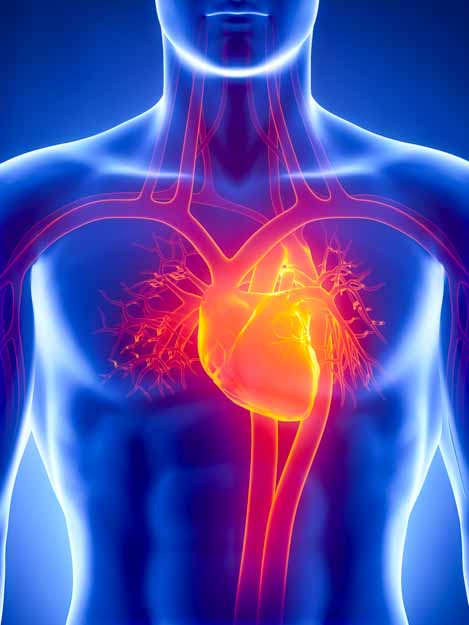Acupuncture prevents atrial fibrillation (AF) and associated cardiac damage. Research published by Zhu et al. finds acupuncture applied to acupoint Neiguan (PC6) has an anti-arrhythmia effect and prevents atrial fibrillation through restoration and remodeling of the right atrial appendage. This is consistent with findings presented by the Heart Rhythm Society and published in the Heart Rhythm Journal. 
The Heart Rhythm Journal research article covered an extensive forum on the treatment and prevention of atrial fibrillation. The publication reads, “Recent small studies suggest that neuromodulation through skin or subcutaneous tissues may also help to control AF using either a transcutaneous approach or acupuncture.” Authors include Dr. Robert M. Califf (US FDA Commissioner) and other doctors from a multiplicity of prestigious institutions including Harvard Medical School (Boston), Johns Hopkins University School of Medicine (Baltimore), Duke University (Durham), and University of California (Davis). The Heart Rhythm Society is dedicated towards advancements in cardiac pacing and electrophysiology.
The Heart Rhythm Journal publication cites a highly relevant study published in the Journal of Cardiovascular Electrophysiology (Lomuscio et al.). The study concludes, “Our data indicate that acupuncture treatment prevents arrhythmic recurrences after cardioversion in patients with persistent AF. This minimally invasive procedure was safe and well tolerated.”
The same acupuncture point (PC6) was used in both the Journal of Cardiovascular Electrophysiology research and that of Zhu et al. In addition, regulation of the heart with PC6 is consistent with Traditional Chinese Medicine (TCM) therapeutic principles. TCM principles designate Neiguan (PC6) as the Luo-Connecting acupoint of the pericardium and stipulate that the therapeutic actions of PC6 include regulating the heart including its rate and rhythm.
The modern laboratory and clinical findings of Zhu et al. and Lomuscio et al. are consistent with ancient TCM acupuncture principles. Lomuscio et al. used acupoints Neiguan (PC6), Shenmen (HT7), and Xinshu (BL15) in their human clinical research. The aforementioned acupoints are important heart related acupoints in TCM.
Zhu et al. conducted an animal laboratory experiment and limited acupuncture to only one acupoint (PC6). Zhu et al. note, “These results suggest that the anti-arrhythmia effect of acupuncture may be mediated through the restoration and modification of remodeling of right atrial appendage.” Zhu et al. add that acupuncture at PC6 “could effectively prevent the onset of arrhythmia and restore the sinus rhythm in AF rats.” Results were confirmed with electrocardiograms, histological examinations, ultrastructure analyses, and statistical analysis. Zhu et al. concluded, “Considering that acupuncture was safe, effective, without any pro-arrhythmic effect compared with the classical pharmacological therapy, this traditional Chinese medicine had a potential to become a more mainstream complementary intervention in the treatment of atrial fibrillation.”
Electrocardiograph analysis by Zhu et al. confirms that the application of acupuncture at acupoint PC6 causes significant reductions in atrial fibrillation maximal durations and P-wave dispersion. Dilaveris et al. note that “P-wave dispersion constitutes a recent contribution to the field of noninvasive electrocardiology and seems to be quite promising in the field of AF prediction.” Zhu et al. add that acupuncture reduced pathological morphological responses to AF. Acupuncture reduced the severity of “focal interrupted cardiomyocytes, myolysis, interstitial edema and increased extracellular space.” 
The work of Zhu et al. documents that acupuncture protects the cardiac ultrastructure from AF damage. The AF control group that did not have acupuncture had a “significantly higher number of cardiomyocytes with disassembled sarcomeres, and an increased number of swollen mitochondria with fusion of mitochondrial were identified. The intercalated discs also appeared to be interrupted.” Acupuncture circumvented cardiomyocyte damage. Zhu et al. report, “In the Acupuncture groups, the sarcomeres were organized normally and although some lightly swollen mitochondrial was observed, there were no major signs of ultrastructure compared with the amiodarone controls.”
The Heart Rhythm Journal publication makes an important acknowledgement: “Emerging evidence related to diet, caffeine, yoga, and acupuncture represent potentially important steps forward in the incorporation of patient-driven prevention research.” This is an indication that viewing the treatment and prevention of atrial fibrillation in a holistic and integrative manner is substantiated by scientific research. The publication notes that AF prevention focus requires a shift from “procedures on individual patients” to “risk factor reduction” and calls for greater collaboration and cooperation between clinicians, investigators, scientists, government, industry, professional societies, and health care systems. The move towards cooperative treatment protocol development is a shift from procedure based medicine to positive patient outcome based medicine.
In a related study, Li et al. conclude that acupuncture improves cardiac function. As in the aforementioned research, acupoint PC6 was used in the investigation. PC6 was paired with another acupuncture point: LI4 (Hegu). In a laboratory experiment, measurements were taken of myocardial hypertrophy indices, electrocardiograph readings, structural changes of the heart, levels of plasma angiotensin II (Ang II) and endothelin (ET), protein expression of extracellular signal-regulated kinase (ERK), and signal regulating kinase of the left heart ventricle. Li et al. conclude, “Our experimental results showed that Ang II and ET participate in the formation of MH (myocardial hypertrophy) and that EA (electroacupuncture) can improve MH by regulating the role of neuroendocrine-cytokines.”
References:
Zhu P, Zhang M, Yang M, Puji D, Guo Y. Acupuncture Prevents the Atrial Fibrillation through Improving Remodeling of Atrial Appendage in Rats. J Tradi Med Clin Natur. 2016;5(186):2.
Van Wagoner DR, Piccini JP, Albert CM, Anderson ME, Benjamin EJ, Brundel B, Califf RM, Calkins H, Chen PS, Chiamvimonvat N, Darbar D. Progress toward the prevention and treatment of atrial fibrillation: A summary of the Heart Rhythm Society Research Forum on the Treatment and Prevention of Atrial Fibrillation, Washington, DC, December 9–10, 2013. Heart rhythm: the official journal of the Heart Rhythm Society. 2015 Jan;12(1):e5.
Najm WI. Efficacy of acupuncture in preventing atrial fibrillation recurrences after electrical cardioversion. Medical Acupuncture. 2011 Mar 1;23(1):61-2.
Dilaveris, Polychronis E., and John E. Gialafos. "P‐wave dispersion: a novel predictor of paroxysmal atrial fibrillation." Annals of Noninvasive Electrocardiology 6, no. 2 (2001): 159-165.
Evidence-Based Complementary and Alternative Medicine. Volume 2012 (2012), Article ID 792820, 9 pages. Electroacupuncture at PC6 (Neiguan) Improves Extracellular Signal-Regulated Kinase Signaling Pathways Through the Regulation of Neuroendocrine Cytokines in Myocardial Hypertrophic Rats. Jia Li, Jing Li, Fengxia Liang, Yaqun Hong, Song Wu, Hongtu Tang, and Hua Wang.


